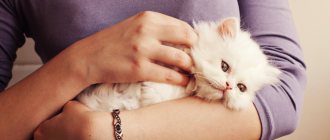Fluffy sunbeam hunters, having fun playing with their own tails, quickly become adult cats and female cats. Most of the time they lie in their favorite chair, curled up. Once cats reach six months of age, their behavior changes. They become interested in the opposite sex. During this period, the pet can become pregnant. The owner would like to know how many kittens the cat bears.
Puberty of cats
The onset of puberty depends on belonging to a particular breed. For example, Siamese and Balinese ripen earlier. Representatives of large-bodied breeds, Maine Coon and Scottish Straight, are distinguished by late maturation. Physiological maturity also depends on the time of birth of the kitten. Those born in summer become sexually mature faster than in winter.
During the maturation period, the so-called “cat” songs begin. These are gentle meows and uterine sounds that communicate intentions. Such “concerts” can last a long time . The cats become overly affectionate and loving. They constantly clean themselves up and mark their territory. They often rub against the owner's legs and the legs of tables and chairs. A caring owner understands that it is time for the pet to look for a partner. But when your cat is in heat for the first time, you should not pair her with a male cat. Puberty does not yet indicate the complete physical development of an animal.
The body's readiness to bear healthy kittens occurs at fourteen months.
It happens that a cat demands a cat, but due to her age she is not yet ready for pregnancy. In this case, on the advice of a veterinarian, you can reduce libido with medications. This will calm your pet, and she will stop asking to go outside. The owner will protect himself from unplanned mating and the associated unwanted pregnancy of the cat. During courtship, cats receive multiple wounds in fights with rivals. After running away from home, pets can return infected with various diseases, including parasites. Therefore, during the period of heat, owners should carefully monitor their pets.
Features of the first mating
During the first heat, it is advisable to isolate a teenage cat from contact with the opposite sex. This must be monitored especially carefully if she has free access to the street, which most often happens in private houses. Before the body is fully formed, any pregnancy should be excluded. Kittens born to a young mother have health problems. The life of the cat itself is jeopardized by early birth. Therefore, for the well-being of her and future kittens, it is advisable to pair her with a male cat after the second or third heat.
Representatives of some breeds are bred for the first time at one and a half years old. Before this, you need to show the cat to the veterinarian . It will determine how mature the pet’s body is to bear healthy offspring. It may be necessary to compensate for the lack of vitamins and microelements before the impending pregnancy. All necessary vaccinations must be completed. Also, if necessary, the veterinary clinic will treat your cat for diseases and parasites. Prescribed drugs cannot be taken during pregnancy, so all treatment is carried out before the expected event.
Purchasing a kitten
It is best to adopt a kitten at 3-4 months: at this age, adaptation to a new home and separation from its mother will occur painlessly. When choosing, it is important to pay attention to the pet’s behavior. It is believed that the animal's high activity and playfulness indicate its good health.
What to pay attention to:
- absence of “whistle” when the animal breathes;
- smooth and clean fur (there should be no wounds or ulcers on the body);
- absence of black spots on the ears, mucus in the corners of the eyes and nose;
- availability of a veterinary passport in which vaccinations will be recorded.
At 12-16 weeks, the kitten should already be accustomed to the tray and scratching post.
Initial signs
It is difficult to find out if a cat is pregnant at first.
Symptoms that indicate that she is expecting offspring appear after 3-4 weeks:
- behavior becomes calm. The cat sleeps constantly;
- some feel weak, and occasionally you may notice that the animal is vomiting;
- appetite and food preferences change;
- becomes aggressive towards the opposite sex: hisses and arches his back;
- after 20 days the nipples turn pink;
- at four weeks, when stroking the cat, you can notice the cubs moving;
- at 5-6 weeks the belly becomes large;
- a cat's weight increases 1.5 times during pregnancy;
- 10-14 days before birth, the search for a place to build a nest begins.
At the veterinary clinic, ultrasounds are performed to determine how long the cat will bear kittens. The study is carried out two weeks after mating.
After 10 days, its presence can be determined by palpation. This procedure is carried out within a matter of days. Then it will be difficult to palpate the cubs due to the large amount of amniotic fluid in the uterus.
Where is the homeland of the Thai?
Thai cats in Thailand were known in the 14th century and were very similar to Siamese. Animals were considered sacred and lived in Buddha temples or the emperor's palace. Export from Thailand was prohibited, so Siamese cats arrived in European countries only in the 19th century. The Thai monarch gave several kittens to a British general who was visiting the country. In Europe, Thais were very popular with local cat lovers, and later cats of the Thai breed were brought to America. And in the middle of the 20th century, theater figure S. Obraztsov brought several animals from his European tour. Professional breeding of Thai cats began, and mixed breeds of various colors were crossed. In 1990, the standard was recognized by German felinologists and the World Cat Federation and officially received the name Thai.
Duration of pregnancy
No one can accurately predict how many days cats carry kittens. But the approximate period lasts about 9 weeks. There is a deviation of 5 days in one direction or another. Premature babies are born weak and non-viable. Post-term pregnancy is also unfavorable for the health of the babies. But it happens that they are born healthy, without pathologies, even if they deviate from the gestational age. This is possible with a special balanced diet and good conditions for keeping the pet. If pregnancy is delayed by one week, you should contact your veterinarian.
It is believed that the period can be determined by the breed.
But it can also depend on the length of the animal’s fur:
- According to this theory, short-haired representatives give birth to kittens a week before the usual due date. These include sphinxes and orientals. This is due to rapid metabolic processes in the body. Naturally, this also affects the early development of the fetus. The kittens will be born healthy;
- cats with medium length hair, such as Siamese, Burmese and Scottish, give birth to kittens 3-5 days before the standard gestation period;
- Representatives of long-haired breeds bear their young the longest. These are Maine Coons, Persian and Siberian.
Before giving birth, your cat is unusually restless. Attentive owners should not lose sight of their pet.
By this time, the delivery area should be prepared. Otherwise, the cat will find it herself, for example, a closet with clothes, a laundry basket or a bed.
How do I know when labor is over?
In the normal interval, the end of labor in cats is characterized by the following features:
- About an hour after the last kitten was born, her belly became soft.
- A cat can leave kittens.
- When all the kittens are born, the cat may become interested in food or water.
- Breathing becomes smooth and heartbeat becomes calm.
- The new mother begins to take care of her offspring, actively caring for the babies.
It is necessary to carefully and effortlessly feel the cat's abdominal area with both hands, making movements towards the ribs. This should be done at least half an hour after the birth of the last kitten.
A cat's calmness does not always mean that the overall process has already been completed. Most animals do not change their behavior during or after birth. If in doubt whether there are any unborn kittens left, consult a professional.
Main stages
The process of forming kittens from conception to birth is quite complex.
The following important stages of their development during pregnancy are distinguished:
- The first stage covers a month after mating the animal. Hormonal changes occur in the body. This affects character and behavior. The cat becomes affectionate and calm. Her nipples swell and their color changes. The process of embryo formation begins in utero.
- The second stage includes 5-6 weeks of pregnancy. The pet is sleeping at this time and needs a sufficient supply of food. The future offspring develops intensively inside the mother. This can be seen as the cat's belly size and weight increase.
- At the next stage, the future kittens are formed. They gain weight and become active, which causes the abdomen to sag. The cat changes dramatically: the maternal instinct awakens. She prefers to be with small children if there are any in the house.
- The time of formation of fur in cubs is difficult. During this period, all internal systems of the body are launched. Due to the increased intensity of metabolic processes, the excretory function increases. This affects the condition of the expectant mother. Her appetite decreases, which can lead to a complete refusal of food.
- The last stage begins at 8 weeks. Future kittens are quite large. The mother cat may have urinary incontinence. 1-2 days before lambing, she becomes restless and begins to look for a place where she can give birth to kittens.
Effect of vaccination on fertility
According to the results of scientific studies, the use of the vaccine does not worsen the condition of reproduction in men and women, and does not affect the genital organs. 200 representatives of both sexes of reproductive age were experimentally vaccinated with Sputnik V. They received 2 doses 90 days apart.
Before and after the procedure, the participants were fully examined: sonography of the pelvic organs, antibodies in the blood, hormonal panel, female ovarian resource, spermogram (in men). No disturbances in male or female fertility were found. Diagnostic indicators before and after vaccination were identical for each study subject. This means that vaccinations are safe and cannot cause infertility.
If men developed a fever while receiving the vaccine, this could negatively affect spermatogenesis. But sperm are renewed every 2.5-3 months. Therefore, examinations were carried out after 90 days and temporary disorders had no significance. In Russia, it is planned to study the effect of other vaccines on a person’s ability to reproduce.
Estrus during gestation
There are cases of estrus occurring during pregnancy. This occurs in one in ten cats. Most often this happens at 3-6 weeks. If at this time there was mating with a male, then secondary conception occurs. The newly fertilized egg is implanted in the uterus. Embryos also develop from it. At birth, these offspring turn out to be premature compared to those already formed. In most cases it dies. Kittens of the second conception sometimes remain in the uterus and may be born a week after the first.
Gestation period and number of kittens
Owners are concerned about the effect of the number of offspring on the duration of pregnancy. Although there is no scientific confirmation of this, it is still noted that the more kittens, the shorter the gestation period. In this way, nature protects the mother’s body from exhaustion. The variation in the number of kittens is quite large. This is influenced by many factors, the main one of which is the physiological characteristics of the animal.
The length and number of kittens a cat bears depends on the breed.
For example, the Siamese breed is characterized by multiple births: up to 13 babies are born in one lamb. Gestation time is 8-9 weeks. Large breed cats give birth to four kittens, which last a long time. The female of the Scottish breed carries her offspring from 8 to 10 weeks.
Also, the number of cubs depends on the age of the pet. A first-time cat gives birth to 1-3 kittens; her body is not yet ready for multiple pregnancies. In the future, she can bear up to 6 cubs. An aging cat may give birth to one or two kittens.











